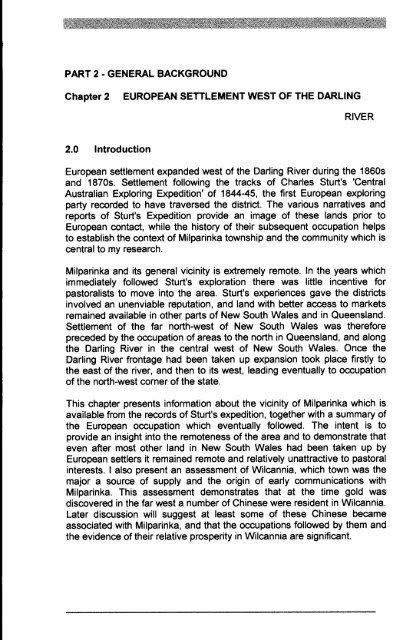Adec Preview Generated PDF File - The Sydney eScholarship ...
Adec Preview Generated PDF File - The Sydney eScholarship ...
Adec Preview Generated PDF File - The Sydney eScholarship ...
Create successful ePaper yourself
Turn your PDF publications into a flip-book with our unique Google optimized e-Paper software.
PART2·GENERALBACKGROUND<br />
Chapter 2 EUROPEAN SETTLEMENT WEST OF THE DARLING<br />
2.0 Introduction<br />
RIVER<br />
European settlement expanded west of the Darling River during the 1860s<br />
and 1870s. Settlement following the tracks of Charles Sturt's 'Central<br />
Australian Exploring Expedition' of 1844-45, the first European exploring<br />
party recorded to have traversed the district. <strong>The</strong> various narratives and<br />
reports of Sturt's Expedition provide an image of these lands prior to<br />
European contact, while the history of their subsequent occupation helps<br />
to establish the context of Milparinka township and the community which is<br />
central to my research.<br />
Milparinka and its general vicinity is extremely remote. In the years which<br />
immediately followed Sturt's exploration there was little incentive for<br />
pastoralists to move into the area. Sturt's experiences gave the districts<br />
involved an unenviable reputation, and land with better access to markets<br />
remained available in other parts of New South Wales and in Queensland.<br />
Settlement of the far north-west of New South Wales was therefore<br />
preceded by the occupation of areas to the north in Queensland, and along<br />
the Darling River in the central west of New South Wales. Once the<br />
Darling River frontage had been taken up expansion took place firstly to<br />
the east of the river, and then to its west, leading eventually to occupation<br />
of the north-west corner of the state.<br />
This chapter presents information about the vicinity of Milparinka which is<br />
available from the records of Sturt's expedition, together with a summary of<br />
the European occupation which eventually followed. <strong>The</strong> intent is to<br />
provide an insight into the remoteness of the area and to demonstrate that<br />
even after most other land in New South Wales had been taken up by<br />
European settlers it remained remote and relatively unattractive to pastoral<br />
interests. I also present an assessment of Wilcannia, which town was the<br />
major a source of supply and the origin of early communications with<br />
Milparinka. This assessment demonstrates that at the time gold was<br />
discovered in the far west a number of Chinese were resident in Wilcannia.<br />
Later discussion will suggest at least some of these Chinese became<br />
associated with Milparinka, and that the occupations followed by them and<br />
the evidence of their relative prosperity in Wilcannia are significant.




